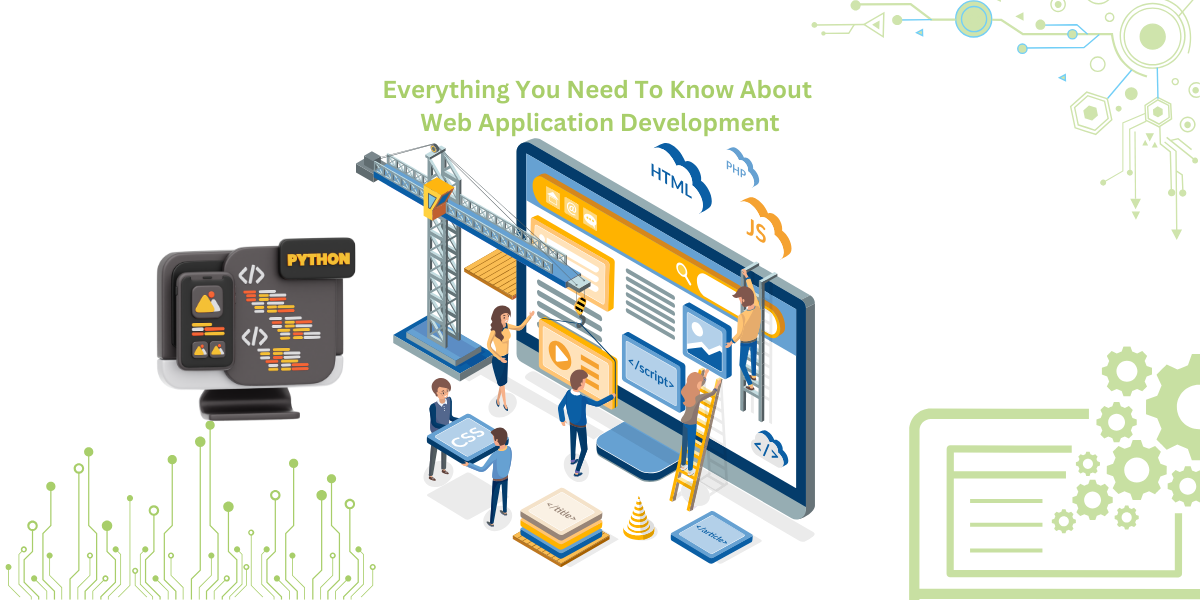Everything You Need to Know About Custom Web Application Development
Web application development is a foundation of today’s tech world. It is what powers the websites and tools we use every day, like online stores and social media. Primarily, web apps allow you to access the services from your browser without downloading anything. Every business needs a rock-solid web app these days. It’s how you stay connected with customers, whether they’re on their phone, tablet, or laptop. That’s why good, reliable, and efficient web applications really matter.
Data integration custom software helps businesses unify data from multiple sources into one platform, enabling smarter decisions, streamlined workflows, and personalized web application experiences. Using Sencha Ext JS, developers can accelerate the creation of reliable, feature-rich, and secure web application development, ensuring both performance and data protection. Learn what is software development platform is and how it empowers modern web application development for businesses.

This blog will cover all the essentials to develop web application. We’ll walk you through by starting with explaining what web applications are and why they are important. Then, we’ll go through the development process, from setting goals to finally launching the app.
In the last, you’ll learn about native and hybrid apps, essential skills, and the top technologies developers use, such as Ext JS. Let’s get started.
What Is A Web Application?
The web application is software that allows user interaction by using different web browsers. We must know that a web application runs on a web server. It consists of a user interface that sends back all the user-generated content to the development team.
The user engagement and other data give us insight into consumers’ preferences, interests, and usage patterns. We may start thinking about the benefits of getting insights into consumers’ data. Well, this data can help us make big marketing decisions.
Moreover, all this data is also helpful for marketing our products available on the website. Due to this amazing benefit, the web application is gaining popularity across all sectors. A web-based application differs from traditional software because it is accessed through a web browser.
Web applications include platforms like email clients, CRM systems, and even customised dashboards. These apps are built to flex and grow as needed. They’re easy to maintain, too, which saves headaches down the road. The best part is that you can customise every piece. Master the rapid web application development process to build scalable, high-performance apps faster and more efficiently.
Need special features? No problem, that’s why custom web app development is booming. Cloud tech changed everything. Now, deploying web apps costs less, and updates happen instantly. Users never need to download patches; it just works.
For growing businesses, web apps are a no-brainer. They work anywhere, anytime – no fuss. And the best part is that they automatically stay current without any extra work on your end.
What Is Web Application Development?
Different factors help us develop an app. The first and most important one is to set the objective for our apps’ use. Setting the objective of our app refers to the purpose of web apps in website application development. For example, is it a product-selling web app or something that helps in job applications? No matter the purpose, it will guide us in designing the user interface.
In the case of customized web application development, clearly defined goals are essential for tailoring functionality to user needs. Similarly, custom web based application development requires a strategic understanding of the app’s purpose to ensure seamless integration of features and optimal user experience.
The user interface of our web apps can give us information about users’ behaviour when visiting our web apps. Thus, we should build a web app in such a way that it accepts and acts on users’ generated data. Some tasks that come under web application development are:
- Compatibility with both iOS and Android.
- Identification of optimisation metrics and life cycles.
- Development of an interactive and intelligent user interface.
Custom web application development tools and services focus on tailoring features to specific business goals. This often involves creating scalable, secure web applications that can handle enterprise-level workflows. Businesses seeking to develop a web application usually partner with a web and application development company that offers end-to-end solutions, from strategy to deployment.
Also Read:Why Low-Code Application Development Software Is Gaining Momentum in 2025
Native Apps vs. Hybrid Apps
So you’re building a mobile app? First thing you gotta decide – native or hybrid? Been there, done that. Let me tell you, neither option is perfect – they both have their quirks.
Native apps? They’re like custom-tailored suits. Made specifically for iOS (Swift) or Android (Kotlin). Fits the platform perfectly, runs buttery smooth, and plays nice with all the phone’s hardware. Photos look crisp, GPS works flawlessly, and users love that stuff.
But that customization comes at a price. You’re basically building two separate apps. Double the code, double the time, double the budget. Still, sometimes that premium feel is worth it, you know?
Hybrid apps are built using web technologies, HTML, CSS, and JavaScript. The trick is that they get packaged in a native shell to run anywhere. Tools like Ionic, Flutter, or React Native make this possible.
The benefit is that one codebase works across all platforms. That means faster development and lower costs. Perfect for startups or simple apps.
But there’s a trade-off. They can’t quite match native app performance, especially for graphics-heavy work. For simple games, hybrid apps work just fine. But for high-end gaming with intense graphics, you’ll want to go native.
Rapid web application development frameworks enable developers to shorten build times for hybrid apps. Progressive web application development services are becoming increasingly popular for delivering app-like experiences within browsers without requiring downloads.
Web Application Development Skills
Web application creation requires various hard and soft skills. Developers need to understand coding, UI, SEO, and more. Below are some essential skills for web developers:
UI and UX Design
Designers have to stick to certain rules; users expect things to work a certain way. Mobile apps often don’t run on desktops, and desktop apps might fail on phones. It’s all about picking the right platform from the start.
Programming Languages
Developers need strategies for automating applications in HTML, CSS, JavaScript, and Python. These languages form the foundation of web applications. Learning web programming is essential for both frontend and backend development.
Analytical Skills
Analytical skills are important for studying user trends and the market. This helps in targeting app advertising effectively.
SEO Knowledge
To rank high on search engines, web applications need good SEO. This increases visibility and helps apps outperform competitors.
Version Control
Developers should manage different versions of an app. Tools like Jira are lifesavers when you need to track down and fix bugs. They show what changed and when, making it much easier to spot problems.
Communication Skills
Effective communication is important for developers. Clients need someone who can explain concepts clearly, which contributes to the app’s success.
Testing and Debugging
Web apps handle large amounts of data, so testing is crucial. Developers conduct security, performance, and usability tests. Browser and accessibility testing are also important. Automated tools help streamline the process.
These skills are vital for secure web application development and customised web application development projects.
Types of Web Applications
Web apps are available in different types. The characteristics of each type of web app depend on how it is developed. Even though we use web technologies in building these apps, they differ based on their architecture. For example, web applications exist in three main categories or architectures:
Client-Side Web Apps
Client-side web apps emphasize user experience by frequently giving them great performance levels. The user interface is the key component of client-side web apps. This is due to the fact that the client-side web programmes dominate the front-end development in these apps.
Server-Side Web Apps
The server-side Software development platforms are also known as backend development. It involves the creation of servers, databases, different background operations, and APIs.
Single-Page Apps
Single-page applications, also known as SPAs, load new pages only when we click on a link. These applications lie in contrast to our conventional multi-page web apps. Interestingly, these apps combine the positive aspects of server-side and client-side apps.
When building custom web apps, developers pick architectures that fit the project’s needs. Sometimes they’ll use just one approach, other times they’ll mix and match. For big business apps handling tons of data, a hybrid client-server setup often works best. This is especially true when working with cloud platforms like AWS.
Frameworks for Web Apps
When we work in a company, they always require appropriate front-end and back-end technologies. It helps us in completing the full-stack web app development process. Some technologies and frameworks that are helpful in creating those web apps are given below:
Front-End
JavaScript
JavaScript is the main client-side programming language that most developers use. We employ JavaScript to add client-side functions to our online and website applications. Learning JavaScript is also very easy in website application development.
HTML
HTML is another tool that helps in creating websites. It helps us to organize the content of our website. There is a large number of characters that help us to show audio, video, and pictures in HTML. We use particular tags to do it.
CSS
CSS defines the look of our web pages in website application development. For example, the colour of our web page and the font of written content are all defined by CSS. Just like HTML and JavaScript, CSS is a foundational technology.
Back-End Technologies
Programming Languages
Handling logins and security checks is back-end work. It also manages all the database stuff, sending and receiving data behind the scenes. If you want to learn back-end coding, then start with Java, Python, Ruby, or PHP. These languages power most of the web’s back-end systems and are great starting points if you’re looking for ideas to learn programming.
Databases
We house our application’s data by using databases in website application development. Databases use query languages to send and receive data. Some query languages are Oracle, PostgreSQL, and MySQL.
Servers
Servers help us in responding to network queries. A server uses internet access to retrieve the data when a client requests it.
APIs
APIs have enabled connecting the functionalities of two different applications or software systems. Moreover, we save time by implementing APIs and not developing anything from scratch.
Understanding the web application architecture for developing dashboard for large dataset AWS is critical for performance-intensive applications, especially in finance, healthcare, and scientific computing sectors.
Web Application Development Process
It is important to follow some important steps when we are developing a web application. Let’s check all the steps here:
Define The Issue
First, figure out what problem your app will fix. Who’s it for? What frustrations do they have? These answers shape everything. Talk to real users if you can. Their needs should drive your app’s features, not just cool tech ideas. Get this part right, and you’ll build something people actually want to use. Skip it, and you’re just guessing.
Schedule The Workflow For Your Website Applications Development
Next, break your work into clear deadlines. You’ll see exactly what needs doing and when. Use tools like Trello or Asana to track tasks, assign work, and adjust when plans shift.
Create A Prototype For Your Web Application
Start by creating a basic prototype of your app’s key features. This demo version lets your team test things early and spot issues before they become costly fixes. Tools like Figma or Adobe XD make this process way faster.
Test Your Prototype
Gotta test your prototype with real people – it’s crucial. Watch how they actually use it during usability tests. Their feedback will tell you if the layout, buttons, and features actually make sense to normal users.
Create Your App
Begin building the actual application using the chosen front-end and back-end technologies. This phase involves database design, API integration, and implementing secure coding practices to ensure your app is both functional and robust.
Examine Your App
Thoroughly test your application in different environments and devices. Perform unit testing, integration testing, and system testing to identify and fix bugs. Security testing is particularly important for enterprise web application development. Understanding the difference between application development vs web development can also help you tailor your testing approach more effectively.
Get Your Web Apps Hosted & Launched
Choose a reliable hosting service, set up your domain, and deploy your application. Make sure to monitor performance metrics and use analytics tools to track user engagement and system health.
Each step is fundamental in creating customised web application development projects. Choosing the best framework for web application development software can significantly affect how efficiently these steps are executed. It all comes together perfectly – easy for people to use and built to handle growth when you need it.
How to Become a Web Application Developer?
Want to break into web app development? Start with the right education. A degree in computer science or web design gives you solid basics. It’s the easiest way for beginners to get their foot in the door.
Certifications can give your resume a nice boost, too. Check out Meta’s Front-End or Back-End Developer programs. Google’s UX Design cert and IBM’s web dev courses are worth looking at as well.
You’ll need both technical and people skills to succeed. Master languages like HTML, CSS, and JavaScript first. But don’t forget soft skills – being able to manage projects and deadlines matters just as much.
How Does Sencha Help In Web Development?
Sencha helps us in the web development process through the fastest JavaScript grid. This is due to the fact that Sencha consists of 140+ high-performing UI components. JavaScript-based data-intensive HTML5 applications can be made with the help of Sencha Ext JS.
The most complete JavaScript framework for creating cross-platform, data-intensive online and mobile applications for any modern device is Sencha Ext JS. With more than 100 incredible data grid features, Sencha is the ideal current enterprise-grade grid solution for React UI.
Sencha WebtestIt significantly improves productivity in building robust and reliable UI tests for web applications. Sencha supports you with more resources in web application development.
Final Thoughts On Website Applications Development
The website application development process may seem complex, but it is easy once we know all the steps. But before developing a web, we should have a strong problem to address by developing our web. It will make the users prefer our web app to solve their particular issues.
Ext JS at Sencha has the amazing capacity to handle a larger number of records. Moreover, it has a large feature set with full control and customisation. Apart from that, many other features make it easy to integrate with our web apps. Just because someone else already solved this problem doesn’t mean we can’t do it better. We need to add killer features that’ll make users choose our app over the competition. Think about what would really wow people!
Picking the right tools to build your web app is make-or-break. Get this wrong and you’ll regret it later when scaling gets painful. And don’t forget – building regular websites and full-blown web apps are totally different beasts. Each needs its own special tools, planning, and skills. Sencha brings a solution to developers by providing robust tools that streamline the development process and bridge the gaps between these two domains.
FAQs
What is a web-based application?
Web apps are programs that run online; you just open your browser to use them. They live on web servers instead of your computer, so you can access them from anywhere.
How to develop a web application?
Start by nailing down the problem your app solves. Sketch a quick solution, test a basic version, then code it properly with frontend/backend tools.
What is application development?
App development is all about creating software that helps users get things done or solves their problems.
How to create a website application?
Use frameworks and languages like HTML, CSS, JavaScript, and a server-side language like Python. Choose a hosting provider and launch.
What is a web application framework?
It is a software tool that provides libraries and templates to streamline the development of web-based applications, supporting the overall development of web-based application projects.
Which is true of a web-based systems development environment?
It enables collaborative, browser-based development and simplifies deployment compared to traditional desktop applications.
Where can I learn web development?
Honestly, I always tell new devs to hit up Coursera or Udemy first – their courses just click better. And when you get stuck, MDN’s docs are a lifesaver.
What skills do you need to be a web developer?
You gotta master the basics first – HTML, CSS, and JavaScript are absolutely essential. Don’t forget problem-solving skills, clear communication, and UI/UX design know-how too.
How is social media influencing web applications and development?
It encourages interactive features, social login integrations, and influences design patterns based on user engagement trends.
What is web programming?
Web programming is coding for websites and web apps. You work on both the visible parts and the server-side logic.
Start building tailored web apps faster — get your Ext JS trial today.

The selection of a front end framework for enterprise applications remains one of the most…

Every software project begins with a choice that reverberates through its entire lifecycle: which development…

Building software for regulated industries demands more than functional code. Healthcare organizations must protect patient…









